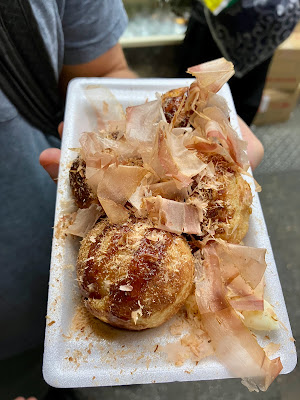Tokyo: Last Looks
We know our readers like pictures of food. We have a lot of photos that just never made it into a blog post, so we'd like to share them here, in no particular order:
Takoyaki - grilled octopus balls
 |
| Matt is actually not a big fan of Takoyaki |
Soba
This platter was served at an Onsen in the Tokyo suburbs. The soba noodles are dipped into the sauce and then eaten. In fact the bottom of the noodle platter is actually slotted. A lot of people make the mistake of pouring the sauce over the noodles and flooding the tray.
One of our last meals in Tokyo was this soba at a highly recommended soba restaurant. Our takeaway? Soba is good but not our favorite.
Yakitori - grilled skewers
These are the mystery skewers from our blooper reel post. We tried to ask what kind of meat it was using only pantomime. Some we liked, others not so much.
The avocado skewers were a surprise hit. We later went to a highly recommended gourmet yakitori place. It was tasty and Matt could see himself having the occasional craving for yakitori.
Miso Many Ways
So you think you know miso? At a market on top of the Toyosu Fish Market, this vendor was selling 12 types of miso paste from all over Japan.
Okonomiyaki
This is a popular kind of savory loaded fried pancake that we've seen in Korea and the US. They're good, but Matt doesn't like the traditional okonomiyaki sauce, which is like a sweet, tangy bbq sauce.
Monjayaki
Monjayaki was one of our big discoveries. It is apparently a specialty of certain Tokyo neighborhoods. We ate it in Asakusa. That big pink thing is cod roe. The rest of the bowl is filled with cabbage and batter. The smaller bowl has cheese.
Unlike okonomiyaki, the batter is thin and runny. The cod roe and cabbage is chopped and mixed with the batter, which spreads out into a thin bubbly layer to cook. You scoop it up with tiny spatulas.
Monjamiyaki doesn't seem very popular or well-known outside of Japan, which is weird because it's delicious. One theory is that it just doesn't look very appetizing. Some have likened it to a puddle of vomit.
We also got a side of garlic on our second visit, when we dragged Matt's sister Kayla to our favorite Monja restaurant.
Chawanmushi
A tasty savory egg pudding
Dessert
As some of our readers may know, for Karen's birthday in 2023 we made chocolate, starting with cacao fruit, fermenting, drying, and roasting the cocoa beans at home. Karen followed the instructions in a book by the founders of Dandelion Chocolate, a single origin bean-to-bar chocolate company in SF. It turns out Dandelion has a second location in Tokyo, and we read that the menu had been specially tweaked for the Japanese palette. Here we have one classic hot chocolate, one hojicha (roasted tea) hot chocolate, and a brownie flight made with chocolate from three different regions.
These "mont blanc" desserts were very popular while we were in Japan- sweetened chestnut puree is extruded and piled high on top of ice cream and other desserts.
Karen's friend insisted we try warabi mochi. Unlike regular mochi (made from rice flour), warabi mochi is made from bracken starch. It is softer than rice mochi. It is traditionally served coated in toasted soybean flour and drizzled with a dark sugar syrup. The mochi only has a very light flavor of its own, and a funny, slippery texture.
A tasty sweet potato cake
Dried Scallops
These dried scallops were sold everywhere and can be added to soups to add a punch of flavor.
Seafood
For 18,000 yen ($120) you can try sea urchin from all over the world, apparently in almost all the colors of the rainbow. We didn't eat here, but Karen and Kayla were definitely tempted.
These oysters aren't so spectacular, but we saw some the size of an adult's hand.
Just some fried fish
Kaitenzushi, or conveyor belt sushi, was a big discovery. We thought that it was less expensive because you're limited to the sushi on the conveyor belt. In fact, the sushi chef makes the sushi for the belt right in front of you and you can request anything you want to be made fresh. So while something must have explained the low prices - the training of the chefs maybe, or the quality of the fish - we couldn't taste the difference, and ate excellent sushi for about $10 each.
At kaitenzushi the color of each plate determines its price and the stack of plates is used to figure out the total cost at the end.
Vegetables
On the hunt for some vegetables, we splurged for this vegetable tempura, which was more expensive than the seafood tempura platter.




























Comments
Post a Comment